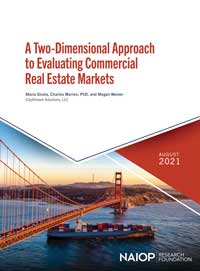Adding Another Dimension to Real Estate Market Analysis

A new model provides fresh insights into industrial and office markets.
Real estate services firms, industry organizations and academic researchers have created a variety of ways to rank and categorize commercial real estate markets. Although these rankings are often subject to debate, a market’s categorization as primary, secondary or tertiary (or as a gateway city, a Tier 2 market or a 16-hour city) can affect whether investors and developers consider projects there.
The NAIOP Research Foundation’s March 2020 report, “A New Look at Market Tier and Ranking Systems,” examined how analysts construct market rankings and how they are used in commercial real estate. The report found that ranking markets may not always be the best way to categorize and compare them with one another. Although a broad range of data go into the creation of market rankings, the rankings themselves provide investors with little information about individual markets. Rankings that are created for a broad audience must also balance often-conflicting priorities: Which markets are attracting the most investment? Which should investors consider? Which markets are the safest? Which are the most profitable? The result of this balancing act is usually a ranking that is of limited use to individual investors and developers, who have different business strategies and risk tolerances.
Last year, the NAIOP Research Foundation commissioned the report’s authors, Maria Sicola, Charles Warren and Megan Weiner of CityStream Solutions, to develop an alternative to traditional market rankings that would allow developers and investors to compare the characteristics of individual markets more easily. The resulting report, “A Two-Dimensional Approach to Evaluating Commercial Real Estate Markets,” evaluates four different models for comparing commercial real estate markets. Using 15 years of market data, each model plots the 50 largest office and industrial markets on a two-dimensional grid that allows investors to quickly evaluate multiple characteristics. This approach allows investors to simultaneously compare a market’s size or pricing to its past volatility and liquidity. The two-dimensional grids resemble the Morningstar Style Box that the investment firm developed to evaluate and compare stocks and mutual funds.
The COVID-19 pandemic has upended many commonly held assumptions about which commercial real estate markets are home to the best investments, with metropolitan areas that commonly top office market rankings like New York and San Francisco experiencing some of the largest downturns in leasing and investment activity. Although the pandemic may be a black swan event, the report’s examination of historical market data reveals that attributes commonly associated with market safety, such as size, average sale prices and transaction volumes, are not reliable predictors of a market’s volatility or its liquidity in a downturn. The largest, highest-priced markets are not always the safest, and some smaller, lower-priced markets have been less volatile than conventional wisdom would suggest.
Switching from a one-dimensional ranking to a two-dimensional grid allows investors and developers to more easily identify the markets that match their strategy and risk tolerance. For example, an office investor interested in increasing the yield on their portfolio without increasing its volatility might consider investing in markets like St. Louis, Las Vegas or Baltimore. These areas have experienced similar levels of volatility as larger markets like Los Angeles and New York, but they generally trade at higher cap rates. Alternatively, a developer who is willing to take on more risk might seek to capitalize on downturns in more volatile office markets like Houston, Nashville or Portland, with the expectation that a future rebound will allow them to sell at a higher price.
A two-dimensional approach to evaluating commercial real estate markets does not remove the need for additional research to identify suitable investments, but it can reveal potential opportunities that are often overlooked in traditional one-size-fits-all market rankings.
Shawn Moura, Ph.D., is the director of research for NAIOP.
|
Get the Report
To view and download “A Two-Dimensional Approach to Evaluating Commercial Real Estate Markets,” visit www.naiop.org/en/Research-and-Publications |





